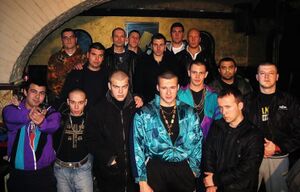Organized Crime in Chrobonsk
This article is considered abandoned lore either because its creator has changed projects or has left the community. Accordingly, it is not only non-canon but it is also eligible for salvage pending approval from an administrator.
|
Organized Crime in Chrobonsk has existed in the country since its independence from Caphiria. In modern times, it consists of prostitution rings, racketeering, drug trafficking, smuggling, money laundering, and in some cases domestic terrorism. While organized crime has always been an issue in the Tzardom, the most recent wave had its start during the post war economic boom of the 1980’s, where organized criminal groups infiltrated the music, television, film, and club industries. The Crime groups in Chrobonsk are the most active and successful on the entire continent of Sarpedon, and chrobonskian gangsters are a cultural staple of Chrobonsk’s perception worldwide.
This is due largely in part to the gangster’s image as a romantic hero in Chrobonsk, as they have historically protected poorer communities from banditry as well as redistribution of stolen wealth from nobility. This perception is shifting to a more unfavorable view in more recent years, due to alleged ties to domestic terrorism and anti-governmental organizations.
History
Origins
Crime groups in Chrobonsk found their start during the Noble Wars before the unification of the country. During this time, many feudal lords neglected their duties to their respective villages to fight over titles and claims. Thus, protection rackets formed around villages to keep them safe from bandits and deserters in exchange for money, women, supplies, or lodging. Criminal organizations of this time also ambushed land trade routes in order to steal gold to redistribute among the poorer villages.

Chrobonsk also has a history of piracy and maritime criminal organizations as well, with gangs infiltrating merchant ships and stealing goods to fence at much lower prices to peasants. Piracy in the region was so bad at one point that the Tzar had to issue mass pardons and letters of Marque to divert the pirates towards trade routes to other nations.
1870 - 1940
Criminal groups in Chrobonsk at the turn of the century largely operated through bootlegging. This is due to the controlled substances act of 1867, which formally outlawed alcohol and a myriad of other psychoactive substances. Many speakeasies and breweries from this era are still in operation to this day, using their prohibitionary past as a means of advertisement. The most famous brand of this alcohol is Uncle Flava’s Homebrew.
After the great wars and the subsequent economic depression of the Tzardom, a large amount of veterans returning from the wars helped reestablish and revitalize organized criminal syndicates. Most of these gangs ran protection rackets on small businesses, as well as small time brothels and opium dens. Virtually all criminal organizations founded after the war still exist to this day, either on their own or absorbed into each other.
1980 - 2000
During the post war economic miracle, organized crime exploded in Chrobonsk. Infiltrating virtually all recreational industries, as well as the mass manufacture and distribution of psychoactive substances such as Marijuana, Cocaine, Methamphetamine, LSD, MDMA, and 2CB. Most profits gained from these enterprises were put into clubs, recording studios, and film budgets as a means to launder money.
Much of Belgrisi’s downtown became a red light district, and a majority of music and film produced was renown for its overtly violent and hyper sexualized nature. Chrobonskian Turbofolk also finds its roots in criminal music production, and still has ties to illegal activities.
The golden age for criminal syndicates came to an end in the late 1990s and early 2000s, when the chrobonskian economic miracle came to an end, and the first Great Recession hit. Because of this, crime groups sought to supplement their lost income through cooperation with domestic terrorists in the provinces.
2000 - Present
While nowhere near its activity at its peak, organized crime is still a large problem in modern Chrobonsk, Bayonet Group still runs nearly every red light district in the country and oversees all inbound and outbound shipments of controlled substances, illegal firearms, and allegedly, human trafficking. Much of this crime goes unpunished due to the fact that Bayonet Group works alongside Fascist Paramilitaries and the Chrobonskian Military to combat The Chrobonskian People’s Front as well as lesser crime syndicates in the mountainous northern provinces of the nation.
The Five Years’ Trouble
In 1985 largest gang war in Chrobonsk’s history was started between the Bayonet Group and Clan Bandits, resulting in thousands of dead civilians and criminals alike as well as millions in damages. This was started when Clan Bandits assassinated a Bayonet Group Lieutenant and his family with a car bomb. Many parts of Belgrisi during this time mirrored warzones, and whole city blocks would have to move into their basements to avoid stray munitions and explosives.

The Royal Constabulary also cordoned off sections of the city to ensure that the violence never spiraled too out of control.